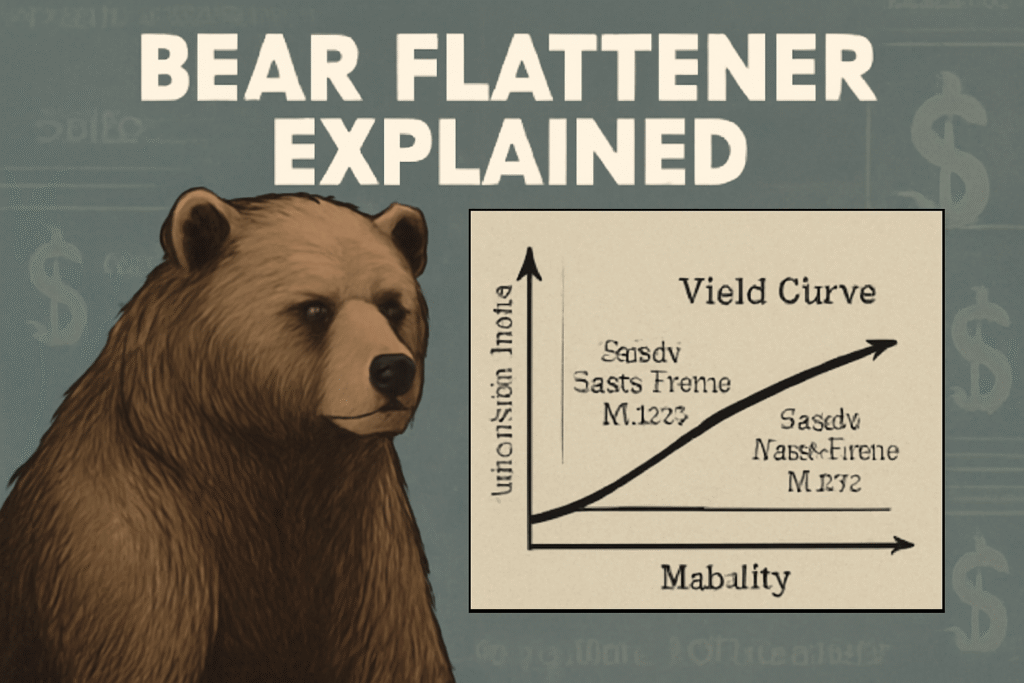The yield curve is more than a graph of interest rates—it’s a window into the market’s expectations for growth and inflation. A healthy economy typically shows a normal yield curve, where longer-term bonds yield more than short-term ones. But when the curve flattens, narrows, or inverts, it tells a story of uncertainty. Investors, policymakers, and analysts rely on these shifts as early warning signals for economic turbulence or financial tightening.
At its core, a yield curve plots bond yields against their maturity. Imagine lining up U.S. Treasury securities from 3 months to 30 years, each showing the return investors demand. Connect those dots, and you get the curve. Its slope matters:
-
Upward sloping (normal curve): Suggests growth and inflation expectations.
-
Flat curve: Indicates uncertainty or transition.
-
Inverted curve: Often precedes recessions.
Types of Yield Curves
There are several shapes investors encounter:
-
Normal: Long-term yields higher than short-term.
-
Flat: Little difference between short- and long-term yields.
-
Steep: Long-term yields much higher, often after recessions.
-
Inverted: Short-term yields exceed long-term, signaling recession fears.
A bear flattener usually develops when short-term rates rise more quickly than long-term ones.
How the Yield Curve Reflects the Economy
The yield curve reflects investor psychology. Rising short-term rates often show tightening monetary policy, while stubbornly low long-term yields suggest skepticism about future growth. In a bear flattener, these forces collide, creating tension in financial markets.
What Is a Bear Flattener?
A bear flattener occurs when short-term interest rates climb faster than long-term rates, flattening the yield curve. The term “bear” refers to falling bond prices (and rising yields) in response to tightening monetary policy or inflation fears.
Essentially, the market is saying: we expect higher rates now, but we’re not convinced growth will hold in the long run.
How a Bear Flattener Differs from a Bull Flattener
-
Bear flattener: Driven by rising short-term yields.
-
Bull flattener: Driven by falling long-term yields.
In both cases, the curve flattens, but the forces behind the movement differ, leading to different investment strategies.
Why It Matters for Investors
For bond investors, a bear flattener signals shrinking spreads between short- and long-term securities. This compresses returns for strategies relying on steep yield curves, such as carry trades. For equity investors, it hints at tighter financial conditions and potential earnings pressure.
Federal Reserve Policies
The Fed plays a pivotal role. When it raises rates to combat inflation, short-term yields jump. If long-term yields don’t keep pace, the result is a bear flattener. Rate hikes in the 1980s, 2000s, and more recently have all sparked this pattern.
Inflationary Pressures
When inflation surges, investors demand higher short-term yields as protection. Yet, if they doubt that inflation will persist, long-term yields may not rise as much, leading to a flatter curve.
Shifts in Market Expectations
Markets constantly recalibrate expectations for growth, inflation, and monetary policy. If traders see aggressive short-term tightening but modest long-term growth, a bear flattener naturally develops.
Impact on Short-Term Treasury Yields
During a bear flattener, yields on 2-year or 5-year Treasuries climb sharply. This makes short-term borrowing more expensive and pressures businesses reliant on credit.
Effect on Long-Term Treasury Yields
Long-term yields may rise slightly or remain steady, reflecting skepticism about sustained growth. The smaller spread between short and long maturities reduces incentives for risk-taking.
How Investors React
Bond investors often rebalance, moving away from short-term securities. Equity markets may grow cautious, particularly in rate-sensitive sectors like housing and technology.
Bear Flatteners and Recession Risk
While not as ominous as an inverted curve, a bear flattener can still signal slowing momentum. It often appears during late-stage economic expansions when central banks tighten aggressively.
Impact on Borrowing Costs
Rising short-term rates hit credit card users, small businesses, and variable-rate loans first. Consumers may see higher mortgage costs, while corporations face more expensive financing.
Corporate Financing Challenges
Companies that rely on rolling over short-term debt face heightened risk. A bear flattener squeezes margins for firms dependent on borrowing at the short end of the curve.
Defensive Investment Strategies
Investors may respond by:
-
Favoring defensive stocks (utilities, consumer staples)
-
Holding cash or money market funds
-
Reducing exposure to rate-sensitive bonds
Opportunities in a Bear Flattener Environment
Not all is negative. Higher short-term yields mean better returns on CDs, savings accounts, and money markets. Skilled investors can also use derivatives to hedge against curve shifts.
Risks to Avoid
The biggest risk is assuming the curve will steepen again quickly. Misreading the signals can lead to mistimed trades and portfolio losses.
Bear Flattener vs. Steepener
A steepener occurs when the gap widens between short- and long-term yields, often during early economic recovery. The bear flattener is the opposite, reflecting late-cycle tightening.
When Flatteners Occur
Flatteners often emerge:
-
Late in business cycles
-
During aggressive Fed tightening
-
Ahead of economic slowdowns
Investor Reactions in Each Scenario
During steepeners, investors flock to equities and riskier assets. During bear flatteners, they grow defensive and cautious.
Past Instances of Bear Flatteners
Historical examples include:
-
Late 1980s tightening cycle
-
Pre-2000 dot-com bubble burst
-
Mid-2000s housing bubble lead-up
-
2018 Fed hikes
Each showed similar patterns of rising short-term yields and cautious long-term sentiment.
Market Conditions Leading Up to Them
Common triggers included inflation surges, aggressive central banks, and market uncertainty about growth sustainability.
Lessons Learned
Bear flatteners remind investors that economic cycles are not linear. Ignoring the signals often leads to overexposure in risky assets just as conditions tighten.
Bear Flatteners in Today’s Market
Recent years have seen several bear flatteners as the Fed combats inflation. Global supply chain issues and geopolitical tensions added to the complexity.
Role of Global Events
Global crises, from pandemics to wars, influence investor psychology. Bear flatteners often emerge when uncertainty pushes capital into longer-term safe assets while central banks raise short-term rates.
Technology and Trading Behavior
Algorithmic trading and real-time data accelerate yield curve shifts. Modern markets react faster, meaning bear flatteners can develop in days instead of weeks.
Hedging During Bear Flatteners
Hedging strategies include:
-
Interest rate swaps
-
Futures contracts
-
Bond laddering
These tools help investors protect against adverse moves.
Diversification Strategies
Holding a mix of stocks, bonds, commodities, and real estate reduces risk. No single asset class dominates during a bear flattener.
Safe-Haven Assets
Gold, Treasuries, and even cash often gain favor. While they may not offer high returns, they preserve capital during volatile periods.
How Banks React to a Bear Flattener
Banks often struggle, as net interest margins shrink. They borrow short and lend long, so a flattening curve squeezes profitability.
Effect on Insurance Companies
Insurers also feel pressure, since investment income from long-term bonds shrinks while liabilities remain.
Pension Fund Challenges
Pension funds that rely on fixed-income securities face reduced returns, making it harder to meet obligations.
Bear Flattener vs. Inverted Curve
An inverted curve goes further, with short-term yields exceeding long-term. A bear flattener can precede inversion, serving as a warning sign.
Bear Flattener vs. Normalization
Sometimes, flatteners are part of normalization after extreme monetary easing. The context matters when interpreting signals.
Predictive Power of Yield Curve Shapes
Economists use curve shifts to forecast recessions, inflation, and policy impacts. The bear flattener is a cautionary sign but not always a doom indicator.
Also read : Hebbia valuation: Understanding the $700M Enterprise Valuation
FAQs
What is a bear flattener?
A bear flattener occurs when short-term yields rise faster than long-term yields, flattening the curve.
How does a bear flattener differ from a bull flattener?
A bear flattener is driven by rising short-term yields, while a bull flattener results from falling long-term yields.
Does a bear flattener mean a recession is coming?
Not always, but it often signals late-cycle tightening and potential slowdown risks.
How does it affect banks?
It compresses profit margins, as banks borrow short-term and lend long-term.
What strategies work best during a bear flattener?
Defensive stocks, diversification, and hedging tools help protect portfolios.
Is a bear flattener good for savers?
Yes, because higher short-term yields benefit savings accounts, CDs, and money markets.
Conclusion
The bear flattener is a critical financial signal, bridging monetary policy, bond markets, and economic cycles. It reveals tension between rising short-term borrowing costs and cautious long-term growth expectations. For investors, it serves as both a warning and an opportunity. By understanding its causes, implications, and strategies, you can protect your portfolio and position yourself wisely in uncertain markets. While not every bear flattener leads to recession, ignoring its lessons can leave investors vulnerable. Staying informed, diversified, and proactive is the best defense against its challenges.



